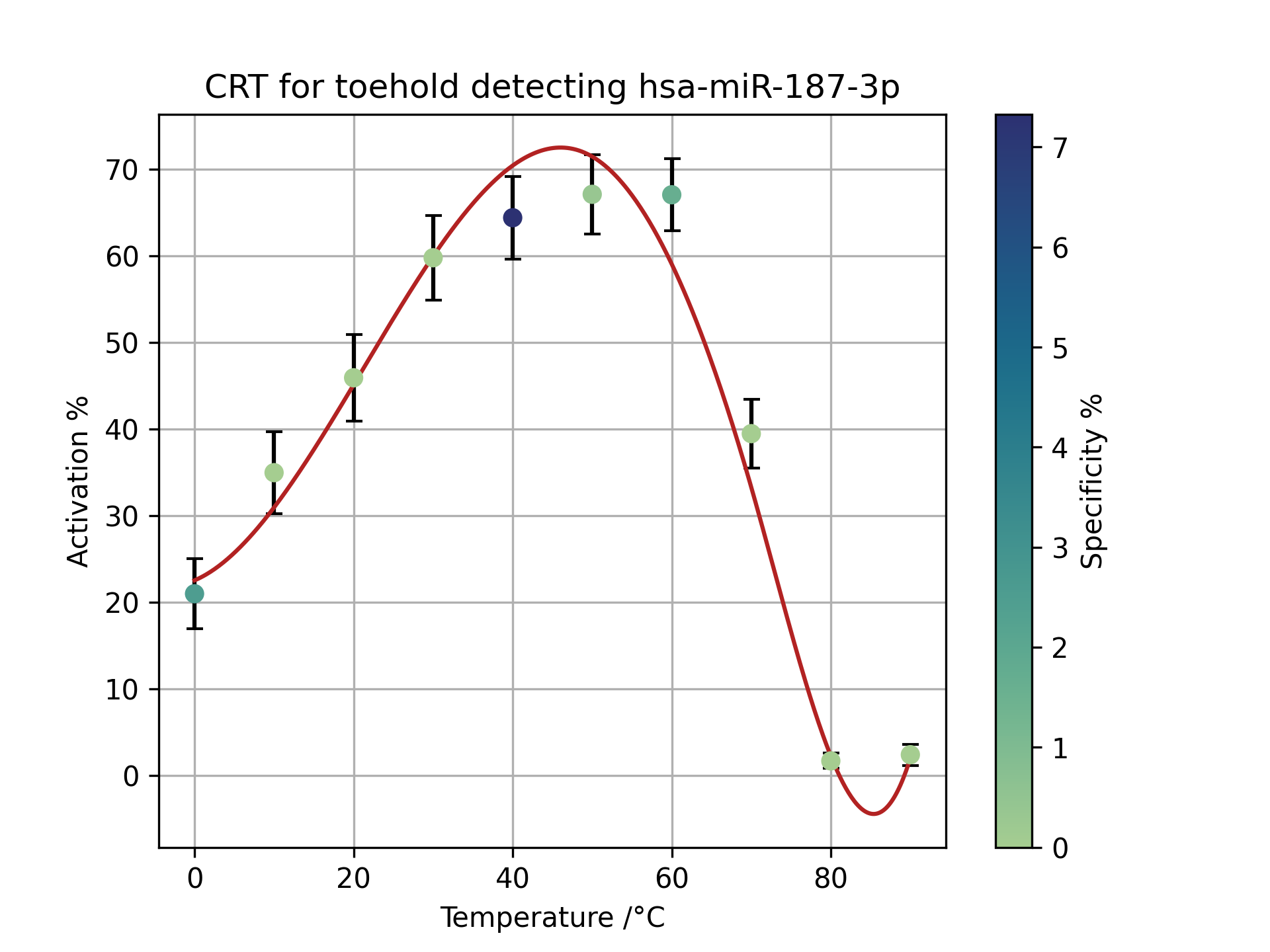Part:BBa_K3431032
zz21_B Toehold Switch for miR-21 Detection
Introduction
zz21_B toehold switch is a regulatory part for the downstream reporter gene. With this part, the protein expression can be controlled by the miR-21. The sequence of the toehold switch can be separated into the following 5 regions from its 5' end: TBS (trigger binding site), stem region, loop region with RBS(ribosome binding site), complimentary stem region with a start codon, and linker. Upon binding with miR-21, its hairpin structure can be opened up and the ribosomes can bind with its RBS (ribosome binding site), triggering the translation of the downstream reporter.
Design
The design of the toehold switch was mainly based on the previous research[1][2][3][4][5][6]. For the zz21_B toehold switch, we adopted the loop and the linker structure from Green et al., 2016[7]. Using NUPACK analysis and Vienna binding models, we designed the sequence of the toehold switch. (See our model page: https://2020.igem.org/Team:CSMU_Taiwan/Model )


Characrterization using invertase
The 2020 iGEM CSMU-Taiwan characterized the toehold switch with invertase (BBa_K3431000) reporter protein. The plasmid would be transcribed and translated with the protein synthesis kit at 37℃ for 2 hours. We would then add 5μl of 0.5M sucrose and measured the glucose concentration with Rightest TM GS550 glucose meter after 30 minutes. In our
experiments, the ON state refers to the conditions with miRNA triggers; while the OFF state means that there was no miRNA in the environment. We calculated the ON/OFF ratio of the toehold switch, which is defined as “the glucose concentration of the ON state/ the glucose concentration of the OFF state”.
.png)
Results
The ON/OFF ratio with miR-21 is 1.32, which suggested the regulatory function of the toehold switch. Thus, zz21_B toehold switch-regulated invertase can be controlled by the miR-21.
Information contributed by City of London UK (2021)
This toehold switch was characterized in silico using the ToeholdTools project that our team developed. See https://github.com/lkn849/thtools for more information.
Metadata:
- Group: City of London UK 2021
- Author: Lucas Ng
- Summary: Used our software ToeholdTools to investigate the target miRNA specificity and activation of this part.
Raw data:
This contribution was autogenerated by the script contrib.py, available at https://github.com/lkn849/thtools/tree/master/registry.
This switch was designed to detect the miRNA hsa-miR-21-5p at a temperature of 37°C. We tested it against every mature Homo sapiens miRNA in miRBase and our analysis shows that at this temperature it is best used to detect hsa-miR-187-3p.
With hsa-miR-187-3p at 37°C, the switch has a specificity of 8 ± 30 % and an activation of 61 ± 10 %. These values represent 95% confidence limits (z=1.96).
The temperature–activation–specificity relationship is shown here. CRT is an acronym for CelsiusRangeTest, the class in our Python library responsible for the following graph:
Error bars represent the standard deviation. The line of best fit was calculated using a univariate cubic spline weighted inverse to each point's standard error.
Caveats:
- As per the above, we cannot confirm that this switch accurately detects the desired miRNA sequence.
We do not recommend this part for future usage.
References
1. Green, A. A., Silver, P. A., Collins, J. J., & Yin, P. (2014). Toehold switches: de-novo-designed regulators of gene expression. Cell, 159(4), 925–939. https://doi.org/10.1016/j.cell.2014.10.002
2. Green, A. A., Kim, J., Ma, D., Silver, P. A., Collins, J. J., & Yin, P. (2017).Complex cellular logic computation using ribocomputing devices. Nature, 548(7665), 117–121. https://doi.org/10.1038/nature23271
3. Pardee, K., Green, A. A., Takahashi, M. K., Braff, D., Lambert, G., Lee, J.W., Ferrante, T., Ma, D., Donghia, N., Fan, M., Daringer, N. M., Bosch, I.,Dudley, D. M., O'Connor, D. H., Gehrke, L., & Collins, J. J. (2016). Rapid, Low-Cost Detection of Zika Virus Using Programmable Biomolecular Components. Cell, 165(5), 1255–1266. https://doi.org/10.1016/j.cell.2016.04.059
4. Chappell, J., Westbrook, A., Verosloff, M., & Lucks, J. B. (2017). Computational design of small transcription activating RNAs for versatile and dynamic gene regulation. Nature communications, 8(1), 1051. https://doi.org/10.1038/s41467-017-01082-6
5. Sadat Mousavi, P., Smith, S. J., Chen, J. B., Karlikow, M., Tinafar, A.,Robinson, C., Liu, W., Ma, D., Green, A. A., Kelley, S. O., & Pardee, K. (2020). A multiplexed, electrochemical interface for gene-circuit-based sensors. Nature chemistry, 12(1), 48–55. https://doi.org/10.1038/s41557-019-0366-y
6. Hong, F., Ma, D., Wu, K., Mina, L. A., Luiten, R. C., Liu, Y., Yan, H., & Green, A. A. (2020). Precise and Programmable Detection of Mutations Using Ultraspecific Riboregulators. Cell, 180(5), 1018–1032.e16. https://doi.org/10.1016/j.cell.2020.02.011
7. Pardee K, Green AA, Takahashi MK, et al. Rapid, Low-Cost Detection of Zika Virus Using Programmable Biomolecular Components. Cell 2016;165(5): 1255-66. Sequence and Features
- 10COMPATIBLE WITH RFC[10]
- 12COMPATIBLE WITH RFC[12]
- 21COMPATIBLE WITH RFC[21]
- 23COMPATIBLE WITH RFC[23]
- 25COMPATIBLE WITH RFC[25]
- 1000COMPATIBLE WITH RFC[1000]
| None |


